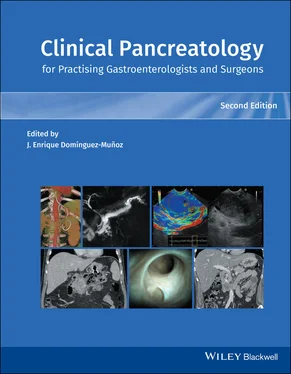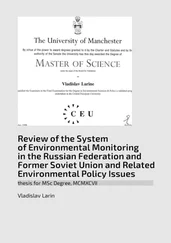15 15 Johnson CD, Abu‐Hilal M. Persistent organ failure during the first week as a marker of fatal outcome in acute pancreatitis. Gut 2004; 53:1340–1344.
16 16 Mofidi R, Duff MD, Wigmore SJ, et al. Association between early systemic inflammatory response, severity of multiorgan dysfunction and death in acute pancreatitis. Br J Surg 2006; 93:738–744.
17 17 Carvalho R, Fernandes R, Santos M, et al. Acute pancreatitis in the elderly: a cause for increased concern? Eur J Gastroenterol Hepatol 2018; 30:337–341.
18 18 Krishna G, Hinton A, Oza P, et al. Morbid obesity is associated with adverse clinical outcomes in acute pancreatitis: a propensity‐matched study. Am J Gastroenterol 2015; 110:1608–1619.
19 19 Nawaz C, Koutroumpakis P, Easler I, et al. Elevated serum triglycerides are independently associated with persistent organ failure in acute pancreatitis. Am J Gastroenterol 2015; 110:1497–1503.
20 20 Sue Y, Batech J, Yadav A, et al. Effect of serum triglycerides on clinical outcomes in acute pancreatitis: findings from a regional integrated health care system. Pancreas 2017; 46:874–879.
21 21 Marshall JC, Cook DJ, Christou NV, et al. Multiple organ dysfunction score: a reliable descriptor of a complex clinical outcome. Crit Care Med 1995; 23:1638–1652.
22 22 Bouwense A, van Brunschot C, van Santvoort G, et al. Describing peripancreatic collections according to the Revised Atlanta Classification of acute pancreatitis: an international interobserver agreement study. Pancreas 2017; 46:850–857.
23 23 Bakker OJ, van Santvoort H, Besselink MGH, et al. Extrapancreatic necrosis without pancreatic parenchymal necrosis: a separate entity in necrotising pancreatitis? Gut 2013; 62:1475–1480.
24 24 Schepers NJ, Bakker OJ, Besselink MG, et al. Impact of characteristics of organ failure and infected necrosis on mortality in necrotising pancreatitis. Gut 2019; 68:1044–1051.
25 25 Padhan RK, Jain S, Agarwal S, et al. Primary and secondary organ failures cause mortality differentially in acute pancreatitis and should be distinguished. Pancreas 2018; 47:302–307.
26 26 Guo Q, Li A, Xia Q, et al. The role of organ failure and infection in necrotizing pancreatitis: a prospective study. Ann Surg 2014; 259:1201–1207.
27 27 Sharma M, Banerjee D, Garg PK. Characterization of newer subgroups of fulminant and subfulminant pancreatitis associated with a high early mortality. Am J Gastroenterol 2007; 102:2688–2695.
28 28 Isenmann G, Rau G, Beger G. Early severe acute pancreatitis: characteristics of a new subgroup. Pancreas 2001; 22:274–278.
29 29 Lee JW, Bhatt JW, Holmes JW, et al. Decreased severity in recurrent versus initial episodes of acute pancreatitis. Pancreas 2015; 44:896–900.
30 30 Anand G, Hutfless SM, Akshintala VS, et al. A population‐based evaluation of severity and mortality among transferred patients with acute pancreatitis. Pancreas 2014; 43:1111–1116.
31 31 Petrov MS, Shanbhag S, Chakraborty M, et al. Organ failure and infection of pancreatic necrosis as determinants of mortality in patients with acute pancreatitis. Gastroenterology 2010; 139:813–820.
4 Early Prediction of Severity in Acute Pancreatitis : What can be Done in Clinical Practice?
Peter J. Lee1 and Georgios I. Papachristou2
1 Division of Gastroenterology and Hepatology, Department of Medicine, Hospital of the University of Pennsylvania, Philadelphia, PA, USA
2 Division of Gastroenterology, Hepatology, and Nutrition, Department of Internal Medicine, Ohio State University Wexner Medical Center, Columbus, OH, USA
Acute pancreatitis (AP) is an inflammatory disease of the pancreas that can lead to gland necrosis, and end‐organ failure in up to 20% of cases [1]. The disease is classified into three severity categories: mild, moderate, and severe pancreatitis [2]. Mild AP occurs when there is no organ failure or local complications such as fluid collection or necrotic collection. Moderately severe AP occurs in patients with transient organ failure (<48 hours duration) and/or acute fluid or necrotic collection and/or decompensation of a comorbid condition due to AP. Severe pancreatitis occurs when organ failure persists for more than 48 hours [2]. The mild category confers low morbidity and mortality, moderately severe implies high inpatient morbidity but low mortality, and severe portends high morbidity and mortality [2]. Given the prognostic implication of severity, early prediction of severe disease thus has been a subject of intense research [3,4].
Over the last several decades, over a dozen prediction tools have been developed using various clinical parameters including examination findings, radiological features, laboratory values, and host‐related characteristics [5–11]. Development of these tools paralleled advances in our understanding of some key pathophysiological markers and mediators of severe pancreatitis. For example, early intravascular volume deficit has long been shown to mediate progression of parenchymal injury to necrosis in animal models and humans [12,13]. This understanding informed exploration of surrogate markers of intravascular volume as predictors of severity, such as blood urea nitrogen and hemoconcentration [5,14]. It is well recognized that severity of host inflammatory response leads to end‐organ injury especially within the first two weeks of disease onset [1,15]. Therefore, investigators studied leukocytosis, elevated C‐reactive protein (CRP), and presence of systemic inflammatory response syndrome (SIRS) as predictors of severity [10,11]. Cytokines such as interleukin (IL)‐1β, IL‐6, IL‐8, and tumor necrosis factor (TNF)‐α have also been investigated as potential biomarkers of severity [16,17]. Prognostic significance of fat saponification and its binding to calcium led to calcium level being included in some of the scoring systems [18]. As with other illnesses, baseline reserve of vital organs has been shown to impact a patient’s probability of survival [19].
Existing prediction tools ( Table 4.1) attempt to assess at least one or more of the following: (i) presence of volume deficit; (ii) severity of host inflammatory response; (iii) age and comorbidity burden; (iv) risk of fat saponification; and (v) early organ dysfunction. In this chapter, we discuss each of these pathophysiological mechanisms, and prediction tools that attempt to assess these early in the course of the disease. Advantages, disadvantages, and future direction are also discussed.
Available Prediction Tools
Volume Deficit
Animal studies have long demonstrated the vulnerability of pancreatic parenchyma to ischemic insults [28,29]. This understanding is the basis for all societies’ universal recommendations for early aggressive fluid resuscitation to prevent microcirculatory compromise [13,30–32]. As such, efforts have been made to find surrogate parameters that represent intravascular volume deficit early in the disease course. The best‐known markers are blood urea nitrogen (BUN) and hemoconcentration (hematocrit). In a landmark observational study using large administrative data, Wu and colleagues showed that BUN elevation and its rise in the first 24 hours of admission was associated with increased mortality and this finding has been validated in multiple subsequent prospective studies using patient‐level data [5,33]. Similarly, hemoconcentration and lack of hemodilution has been associated with pancreatic necrosis in several studies [34].
Table 4.1 Existing scoring systems for prediction of severe pancreatitis.
Source: adapted from Mounzer et al. [6].
| Name a |
Score component |
Comment |
AUC for severe pancreatitis |
| Ranson’s |
Admission: age (>55 years), WBC (>16 × 10 9/l), glucose (>200 mg/dl), LDH (>350 IU/ml), AST (>250 IU/ml) 48 hours: hematocrit (decrease >10%), BUN (increase >5 mg/dl), calcium (<8 mg/dl), P aO 2(<60 mmHg), base deficit (>4 mEq/l), fluid sequestration (>6 l) |
Needs 48 hours of clinical data Requires blood gas and careful fluid balance data: not routinely available in every patient |
0.69–0.72 [6,8] |
| Glasgow |
Age (>55 years), WBC (>15 × 10 9/l), glucose (>180 mg/dl), BUN (>45 mg/dl), P aO 2(<60 mmHg), calcium (<8 mg/dl), albumin (<3.2 g/dl), LDH (>600 IU/l) |
Validated and commonly used in trials including predicted severe acute pancreatitis [20,21] Not all components routinely available or checked P aO 2(<60 mmHg), LDH (>600 IU/l) |
0.73–0.84 [6,10,22] |
| APACHE‐II |
Age, temperature, MAP, heart rate, respiratory rate, A–a P aO 2or P aO 2, arterial pH or HCO 3, sodium, potassium, creatinine, hematocrit, WBC, GCS score, chronic health problems b |
Cumbersome to calculate with lack of clear superiority over other models |
0.77–0.80 [6,8,9] |
| SIRS |
Temperature (<36 or >38°C), heart rate (>90 bpm), respiratory rate (>20/min or P aCO 2<32 mmHg), WBC (<4 × 10 9/l, >12 × 10 9/l or >10% bands) |
Extremely easy to calculate and all components widely available Reflects only one pathophysiological mechanism of severity (i.e. host inflammatory response) |
0.70–0.88 [6,10,23] |
| Panc 3 |
Hematocrit (>44%), BMI (>30 kg/m 2), pleural effusion |
Simple score but it requires a chest X‐ray; inferior accuracy and sensitivity |
0.64–0.76 [6,11] |
| POP |
Age, MAP, P aO 2/ F iO 2, arterial pH, BUN, calcium |
Derived from intensive care unit patients with acute pancreatitis May not be applicable to patients on the regular nursing floor Requires an arterial gas reading |
0.67–0.83 [6,24] |
| BISAP |
BUN (>25 mg/dl), impaired mental status (GCS score <15), SIRS (≥2), age (>60 years), pleural effusion |
Easy to calculate Requires chest X‐ray Most extensively validated among all scores Poor sensitivity, thus low negative predictive value |
0.72–0.90 [6,8,10] |
| JSS |
Base excess (≤3 mEq/l), P aO 2(≤60 mmHg or respiratory failure), BUN (≥40 mg/dl) or creatinine (≥2 mg/dl), LDH (≥2× upper limit of normal), platelets (≤100 × 10 9/l), calcium (≤7.5 mg/dl), CRP (≥15 mg/dl), SIRS (≥3), age (≥70 years) |
More cumbersome to calculate than BISAP score without offering clear performance advantage Requires an arterial blood gas sample |
0.76–0.83 [6,9] |
| HAPS |
Abdominal tenderness, hematocrit (>43% for men or >39.6% for women), creatinine (>2 mg/dl) |
Extremely simple More applicable for patients in the emergency room Designed to identify patients with “nonsevere” pancreatitis |
0.62–0.85 [6,25] |
| PASS |
Organ failure (100 points) SIRS (25 points for each criterion) Abdominal pain (5 points) Morphine equivalent dose (5 points/mg) Tolerating solid diet (yes = 0, no = 1 – 40 points) |
Designed to be measured and followed over time Easy to calculate and measure Needs validation studies |
0.7 [26,27] |
a SIRS, systemic inflammatory response syndrome; Panc, pancreatitis; POP, Pancreatitis Outcome Prediction; BISAP, Bedside Index for Severity of Acute Pancreatitis; JSS, Japanese Severity Score; HAPS, Harmless Acute Pancreatitis Score; PASS, Pancreatitis Activity Scoring System.
Читать дальше












